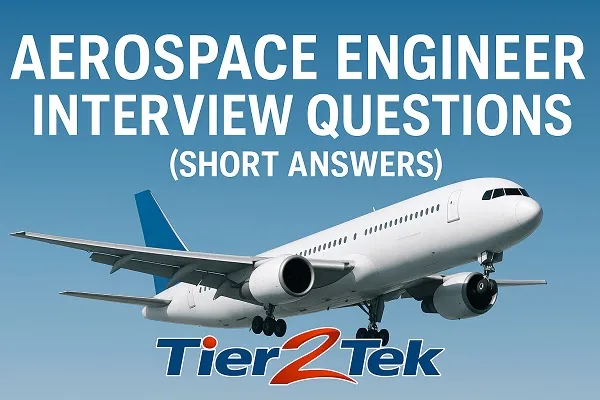Aerospace Engineer Interview Questions with Answers

Preparing for an aerospace engineering interview requires a strong grasp of technical knowledge, practical experience, and problem-solving skills. Whether you’re aiming to work on aircraft, satellites, or spacecraft, the following commonly asked questions with short answers will help you review key concepts and demonstrate your expertise to potential employers.
1. What is aerospace engineering?
Aerospace engineering is the design, development, testing, and production of aircraft, spacecraft, and related systems and equipment.
2. What’s the difference between aeronautical and astronautical engineering?
Aeronautical focuses on aircraft within Earth’s atmosphere, while astronautical deals with vehicles and systems in space.
3. What are the four forces acting on an aircraft during flight?
Lift, Weight (Gravity), Thrust, and Drag.
4. What is Bernoulli’s principle and how does it apply to flight?
It states that as the speed of a fluid increases, its pressure decreases. It explains how wing shape generates lift.
5. What is the Mach number?
It’s the ratio of an object’s speed to the speed of sound. For example, Mach 2 means twice the speed of sound.
6. What is meant by angle of attack?
It’s the angle between the chord line of the wing and the direction of the oncoming airflow.
7. What is the role of CFD (Computational Fluid Dynamics) in aerospace?
CFD simulates airflow and heat transfer to optimize designs and reduce wind tunnel testing.
8. Name a common material used in aerospace structures. Why?
Titanium – it’s strong, lightweight, and resistant to corrosion and high temperatures.
9. What is a control surface? Give examples.
Control surfaces help maneuver the aircraft; examples include ailerons, elevators, and rudders.
10. What causes turbulence?
Turbulence is caused by irregular air movements due to weather systems, jet streams, or obstacles like mountains.
11. Explain the function of an aircraft’s fuselage.
The fuselage is the main body that holds passengers, cargo, and the cockpit.
12. How do rockets differ from jet engines?
Rockets carry their own oxidizer and can work in space; jet engines need atmospheric oxygen.
13. What is thrust vectoring?
Thrust vectoring changes the direction of engine thrust to control the aircraft’s attitude or enhance maneuverability.
14. Why is weight optimization important in aerospace design?
Reducing weight improves fuel efficiency, performance, and reduces operational costs.
15. What safety considerations are crucial in aerospace engineering?
Redundancy, structural integrity, fail-safes, risk assessments, and adherence to strict standards like FAA or EASA regulations.
